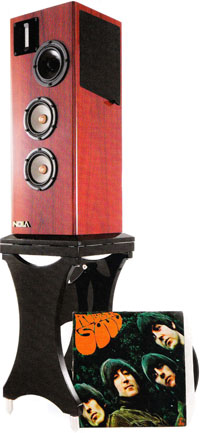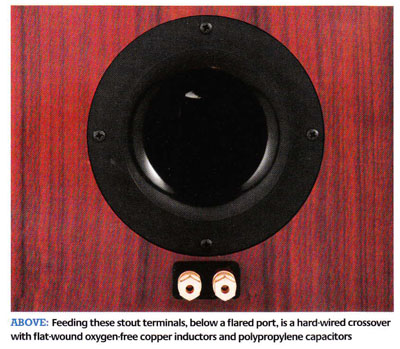
Nola Micro Grand Reference
Can Nola downsize its ten-driver Baby Grand Reference floorstander to make it room-friendly for the UK?
Review: Ken Kessler
Lab: Keith Howard


|
It started when I saw a thin foam square protecting the ribbon during shipping. Removing it betrayed the tug of some serious magnets, but it stayed in place while Ralph, from Artisan Audio, set up the speakers. In under a half-hour, he'd positioned them on their dedicated stands - lightweight and reminiscent of Russ Andrews' Torlyte, only with a heavy gloss black finish to complement the luscious rosewood of the speakers themselves.
A key part of Nola philosophy, the stands act as an energy path. They're spiked down below, but ball-bearings sit between the stand's top plate and the speaker. So they rock. Literally. This creates the only fiddly bit of the set-up procedure. If the stands aren't level, the speaker won't sit squarely. This may or may not affect the sound, but it will gnaw at you because it just won't look right, like a crooked painting in your dentist's office. I handed Ralph a spirit level, and he sorted it in seconds.
Although this didn't apply in my room, which is built directly onto terra firma, the stand's special ball bearing isolation system was also developed to reduce the influence of floor-borne vibrations. Nola designer and CEO Carl Marchisotto explained that, 'The Micro employs a built-in double platform base with ball bearing isolators to reduce coloration. The stand was designed expressly to minimise the "acoustic presence" of a stand, so it can get out of the way of the music. This turned out to be the most effective method to isolate the system from the floor and results in lower coloration and greater dynamics.'
It's odd to be dealing with the stands before the speaker, especially since they're optional, but I doubt anyone would not buy them once they're demonstrated together. In no small way, the looks are a plus, for most speaker stands are hideous metal tubing affairs. These resemble fine Chinese furniture, having a black lacquer finished to piano standards.
GRAND IDEAS
 Carl stated quite clearly that this speaker was designed to deliver
the same musical experience as the Baby Grand, but where space is an
issue. The Baby Grand occupies a space of 1580x46Ox560mm (hwd); on its
stand, the Micro needs only 1155x280x280mn (hwd) - quite a
reduction. To achieve this, Carl quartered the number of 110mm cast
frame alnico magnet mids and ribbon tweeters, swapping two 240mm
woofers for two 120mm cast-frame magnesium woofers.
Carl stated quite clearly that this speaker was designed to deliver
the same musical experience as the Baby Grand, but where space is an
issue. The Baby Grand occupies a space of 1580x46Ox560mm (hwd); on its
stand, the Micro needs only 1155x280x280mn (hwd) - quite a
reduction. To achieve this, Carl quartered the number of 110mm cast
frame alnico magnet mids and ribbon tweeters, swapping two 240mm
woofers for two 120mm cast-frame magnesium woofers.
Like Vandersteen and a couple of others, Nola employs 'open baffle' technology for its mid and treble units; the woofers reside in a ported enclosure. Aesthetically, Nola deals with this by producing a cabinet that looks like a solid box, rather than a cube with a small panel perched on top. But it's a clever illusion: the upper section is a baffle backed by a frame with grilles filling the apertures, so it looks like a conventional parallel-sided box.
Ironically, there is no grille for the front, which may upset the house-proud, who don't like looking at naked drivers. It has yet to cost Nola a sale, but Carl said he'd find a way to deal with it if necessary. He just doesn't like the damage a grille inflicts on the sound. The grilles at the sides are strictly there for looks and do not affect dispersion or tonal balance, as would cloth between driver and listener.
Nola employs a 45° mirror-imaged array for the midrange and tweeter, and further evidence of serious attention to detail because this demands mirror-imaging of the speaker baffles, unlike less-costly vertical arrays which don't require left/right enclosures. The twin woofers, custom-made for Nola by SEAS, are fitted to a rear vented enclosure, the vent being flared to eliminate port noise. The midrange operates as an open baffle dipole, while the open baffle ribbon tweeter eliminates any type of extra diaphragm, as the ribbon is the diaphragm. Carl succinctly states that, 'The lack of an enclosure [in the midrange and high frequencies] eliminates a large source of coloration.'
A REAL BLAST
|
MASS MURDER Carl Marchisotto hates mass. Not the Catholic kind, but the sort that makes speakers sluggish. 'It's about resolution. Our ribbon tweeter has 26 times less moving mass than any known dome. Domes with exotic materials may solve one problem, but they introduce others, which is mass. Diamond domes may be stiff and not break up, but they are heavy. Ribbons offer better resolution and detail. The lack of coloration due to low resonance allows them to be very smooth. Our ribbon - with over 2lb of neodymium magnets - is built just for us in California.' So, too, the proprietary woofers. 'Only 8g moving mass, the speed equivalent to an electrostatic. Only,' he adds, 'with dynamics.' |
So I tried the McIntosh C2200/ MC2102 pre/power pack, a Musical Fidelity player, the Pure io10 iPod dock with a Nano: something about the Nolas targeted virtues rather than flaws, though we know that such selectivity is impossible.
Keep this in mind, because it made assessing them both easier and trickier. Blasted euphony...
My initial burst with the speakers came courtesy of the superbly-recorded Keb' Mo' treasure, Peace... Back By Popular Demand [Okeh/Epic EK92687] and the experience negated the admittedly superb demo I'd heard at CES of one of the Micro's larger siblings, with open reel tapes. The bass! So clean, clear, controlled, coherent! I'm running out of 'C' words - the bass was nearly on a par with the Wilson Sophia 2s, my reference speaker. Slightly cooler, perhaps, but no less impressive.
With the lilting take of 'Get Together', the system just ebbed and flowed, the most liquid-sounding reproduction I've heard of this all-time Pave demo disc, the lower registers filling the room with tactile, uncannily authentic bass. But even that didn't prepare me for the lone piano on 'The Times They Are A-Changin": the requisite ring to the upper keys, the richness in the mid and bass... if tonal accuracy was all we needed, then the Micro is a champion speaker system.
Two other qualities, however, came into play to raise the speaker even higher up the food chain. The first? The vocals were as natural-sounding as one could hope for, belying the disc's digital origins. Nothing marred the phrasing, the voicing - no rasp, no sibilance. But the second framed all of it: utterly transparent openness, reminiscent of Apogee's Diva when driven by a kilowatt of Krell power. You felt as if you could walk around the instruments.
Perhaps the CD was making life simple for the Nolas, given that I'd already noticed their freedom from mismatching. Carl warned me not to worry about the impedance, what he called the 'static' (meaning the speaker's 86dB rating) versus the real-world behaviour of the speakers. At no point was power an issue; the Quads were a match made in heaven, the Class A Luxman positively salacious. But it was all too easy, so I dosed it with some grunge.
 GOOD INTENTIONS?
GOOD INTENTIONS?
Percussion and bass marriages rarely plumb the muddy depths of Nirvana, and there's something about 'Heart Shaped Box' from In Utero [Geffen GED24536] that seems designed to confuse fey sound systems.
Bass player Novoselic and drummer Grohl might not have altered the mix if they'd monitored the recording 17 years ago through Nolas - had they existed - because the album seems deliberately dark and dank. It could even be called 'swampy' had it come from America's southeast rather than northwest. Regardless, the Nolas provided the possibly unwelcome opportunity for the listener to focus on individual instruments, rather than the entire deluge. Which asks of the listener, do you want such detail, especially if that may not be the artist's intention?
I turned to the mono Beatles re-masters, which pre-date grunge (although contemporary with the early Kinks) to hear 40-year-old tracks sounding as if they were recorded by audiophiles. George Harrison's early sitar flourishes possessed metallic twanging to set your cilia waving, just as would a real sitar if you've been blessed enough to hear one in person. Meanwhile, George Martin's piano solo on 'In My Life' took on a presence that nestled eerily between the real and the aetherial.
GRAND FUNK
For all of the neutrality, detail and clarity, there's something 'gossamer' about the small Nola. It caresses sweet voices, strings and the space in which they're recorded. Then it went all funky with Little Feat's 'Tripe Face Boogie', and realised that this is a loudspeaker which will never, ever bore a sophisticated listener.